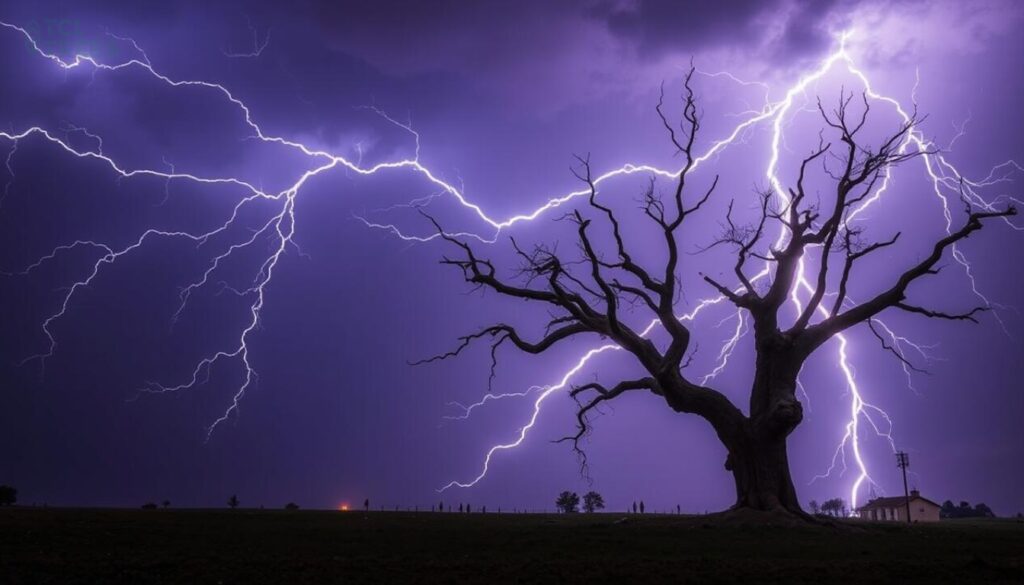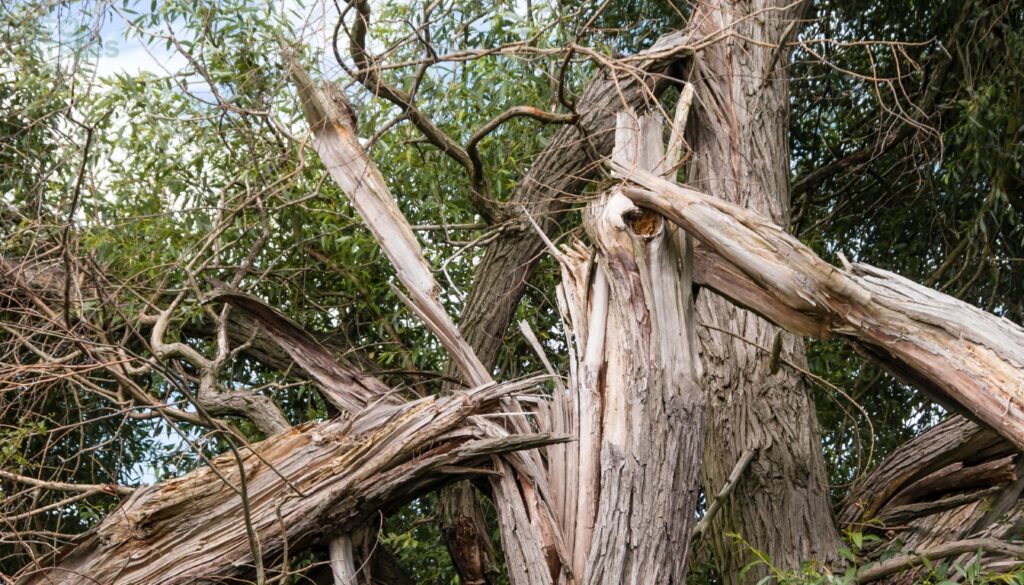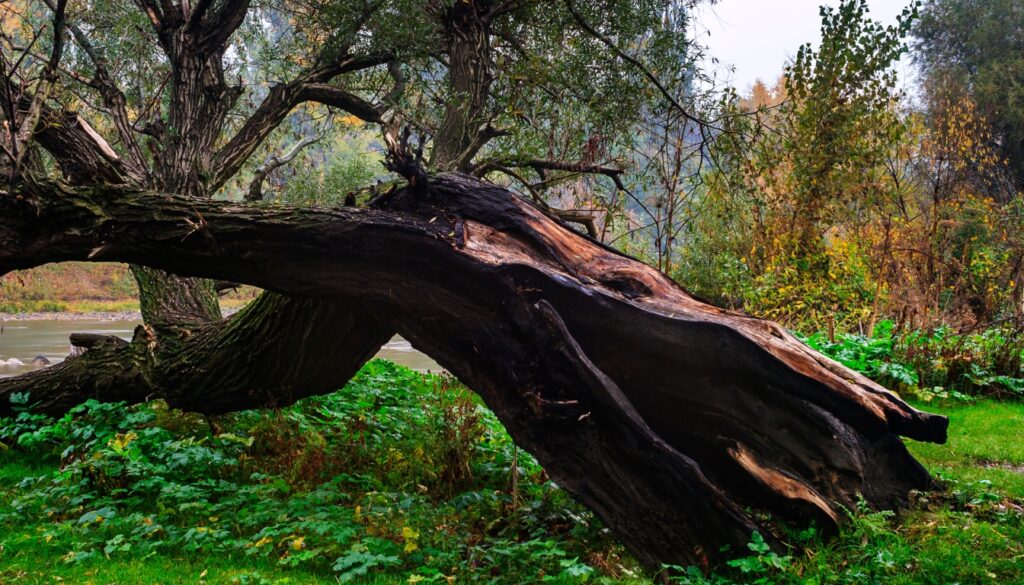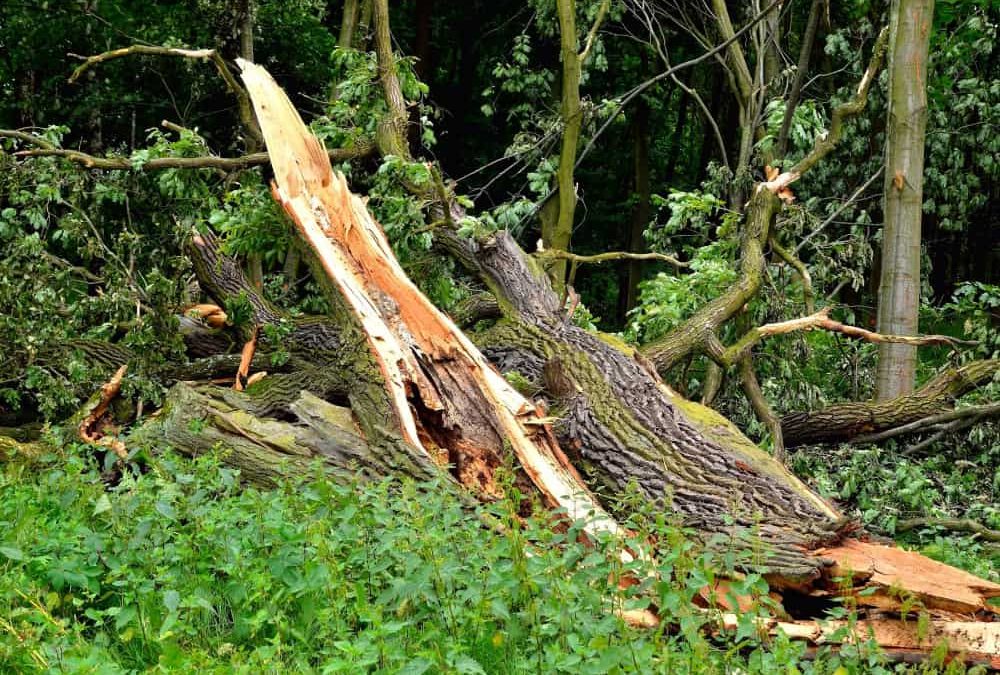Key Takeaways
- Comprehending the Effects of Lightning on Trees and Immediate Steps to Follow After a Lightning Strike
- Assessing the State of a Tree Affected by Lightning and Treatment Alternatives for a Tree Hit by Lightning
- Ongoing Maintenance for Trees Damaged by Lightning and Long-Term Care Strategies
Understanding the Impact of Lightning on Trees
A lightning strike can have a devastating impact on trees, leaving behind visible signs of damage and potential health risks. Understanding what to do if your tree is struck by lightning is crucial for promoting recovery. First, it is vital to identify whether the tree has been affected by a lightning discharge, which can cause bark stripping, splitting, or even uprooting. If a lightning storm has passed through your area and you suspect your tree has been hit by lightning, assessing the damage becomes a priority. Look for signs such as charred bark or blackened wood, which indicate a lightning strike. If the tree is significantly damaged, considering the installation of a lightning rod for future protection might be a wise decision. Being proactive in monitoring and addressing these issues can greatly enhance the survival prospects of trees that have experienced a lightning strike.

Overview of Lightning Strikes on Trees
Lightning strikes can cause significant harm to trees, often leading to severe damage or even death. Understanding what to do if your tree is struck by lightning is essential for recovery. A bolt of lightning can create extreme heat and pressure, shattering bark and splitting wood. Lightning storms pose a greater risk to trees that are tall or isolated, making them more likely to be vulnerable targets. Implementing lightning protection systems, such as lightning rods, can reduce the risk of such strikes in the future.
After a lightning strike, assessing the tree’s health and structure is crucial. Signs such as charred bark, fractures, and loss of leaves may indicate severe damage. Following lightning safety tips can help in mitigating risks during storms and protecting your landscape. For ongoing safety, consider installing a lightning protection system to shield important trees. Awareness of dry lightning, which can occur without rain, can also aid in planning and maintaining tree health.
Signs Your Tree Has Been Struck by Lightning
A tree struck by lightning during a thunderstorm can display several distinct signs. One of the most noticeable indicators is the condition of the tree bark, which may peel away or crack severely. This damage often leads to exposed areas of the tree that are vulnerable to pests and diseases. Knowing what to do if your tree is struck by lightning becomes crucial in these situations. Maple trees, for example, may show signs of wilting or leaf scorch as they struggle to recover from the trauma.
Another common sign involves the appearance of the tree’s branches, which might appear charred or blackened after a lightning strike. Such damage can significantly affect tree care efforts like tree pruning since these branches may need immediate attention. Monitoring the affected trees post-storm is vital; observing any unusual growth patterns or signs of decay will help you decide the best next steps, ensuring the health of the trees remains a priority after experiencing the force of thunder.
Immediate Actions to Take After a Lightning Strike
A lightning strike can cause significant damage to trees, leaving many homeowners unsure about what to do if your tree is struck by lightning. It is crucial to assess the tree trunk for visible signs of explosions, such as bark splitting or deep fissures. Pine trees and poplar trees, which have different structural responses to storms, may require specific attention based on their unique characteristics. After evaluating the damage, immediate safety precautions should be taken to avoid hazards posed by falling branches during high winds. Observing any changes in foliage, especially during the transition to autumn colors, can indicate the tree’s overall health and recovery potential. Understanding these initial steps can help guide your decisions for the future of your landscape.
Assessing the Damage to Your Tree
A lightning strike can leave trees in a vulnerable state, making it essential to know what to do if your tree is struck by lightning. Begin by closely inspecting the bark and branches to identify any visible damage. Look for signs of fire or deep fissures in the bark, which indicate that the impact from the lightning strike could have compromised the tree’s structural integrity. A struck tree may display burnt areas or even splintered wood. Understanding these signs is crucial in determining the next steps for recovery.
Observing the overall condition of the tree is vital after a lightning incident. Consider consulting an arborist to assess the health of lightning-struck trees, as they can provide expert insights about any internal damages that may not be immediately visible. This includes checking for signs of decay, such as soft wood or fungal growth, which could worsen over time. Knowing what to do if your tree is struck by lightning involves not only immediate observation but also planning for ongoing care and treatment to ensure the tree’s survival.
| Damage Type | Signs and Symptoms | Recommended Action |
|---|---|---|
| Bark Damage | Fissures, burns, or peeling bark | Trim damaged areas and apply protective sealant |
| Branch Damage | Splintered branches, broken limbs | Prune broken limbs to prevent further injury |
| Internal Damage | Soft wood, fungal growth, decay signs | Consult an arborist for assessment and treatment |
| Overall Tree Health | Stunted growth, leaf discoloration | Monitor health; consider nutrient supplements |
Safety Precautions to Consider
Lightning poses a serious threat to trees, and understanding what to do if your tree is struck by lightning is essential for its recovery. If you suspect a hit tree, it’s crucial to assess the situation cautiously. Look for signs of lightning damage like a lightning scar, which can indicate that the tree has suffered significant injury. Implementing tree lightning protection systems can help prevent future incidents, serving as your own lightning protection strategy.
After a lightning strike, safety precautions must be prioritised to protect both yourself and the tree. Avoid standing under or near the affected tree until you are certain it is stable. If the lightning passes through the tree and causes structural damage, it may lead to branches breaking or even the tree falling. Engaging professionals for evaluation and potential removal of hazardous sections can minimise risks associated with a struck tree, ensuring your environment remains safe.
Evaluating the Condition of a Lightning-Struck Tree
Assessing the condition of a tree after it has been struck by lightning is crucial for determining the appropriate recovery steps. Lightning strikes can cause significant tree damage, resulting in issues such as tree bark explosions and splintering. It is essential to look for visible signs of damage, including cracked or split branches, as well as any disruption in the tree’s structural integrity. If the tree experiences severe damage, such as extensive splintering, you may need to consider whether it poses a safety hazard. Understanding what to do if your tree is struck by lightning is vital, especially if you plan to implement a lightning protection system in the future. Monitoring storm-damaged trees post-strike will help you identify ongoing issues, guiding your decisions on treatment and care.

Identifying Structural Damage
Assessing the structural damage of a tree after a lightning strike is crucial for its recovery. A tree that escapes damage may still suffer from hidden issues beneath the bark, while an injured tree might present visible signs like splits or cracks. If the entire tree shatters or if large branches are blown off, immediate evaluation is essential. Knowing what to do if your tree is struck by lightning can help determine the necessary steps to protect the tree’s overall health.
Look for any changes in the tree’s shape or stability. Leaning, cracks, or large wounds on the trunk can indicate significant structural compromise. Tree safety should be a priority, especially after an hour emergency tree situation. Ensuring that the tree remains upright and secure is vital for its ongoing health. Regular inspections will help establish whether the tree can recover or if further intervention is necessary.
Monitoring for Disease and Decay
After a thunderstorm, it is crucial to understand what to do if your tree is struck by lightning, especially with big or large trees. Inspect both the entire tree and the individual tree branches carefully for signs of distress or damage. Look for any bark that has split or peeled away, as this can be an indication of internal injury. Fungal infections or unusual growths may signal the onset of decay, which can spread throughout the tree if not identified early.
Monitoring the condition of your tree is essential for its survival. If you notice any signs of disease, such as wilting leaves or discolouration, consult with a professional arborist. Emergency tree removal may be necessary if the damage is extensive. Using tree stakes can help provide stability while assessing and treating the affected areas. Remember, knowing what to do if your tree is struck by lightning can save your valuable trees and ensure their recovery.
Treatment Options for a Tree Hit by Lightning
After a lightning strike, it’s crucial to understand what to do if your tree is struck by lightning. Your tree needs immediate assessment to determine the extent of lightening damage and to address potential threats to its health. Emergency tree services may be required to remove severely damaged sections and to ensure safety around nearby trees. Pruning and properly caring for the affected tree can help mitigate risks of tree diseases that can arise from the injuries sustained. Implementing common tree care practices along with extensive tree care strategies will support recovery and promote healthy growth in the aftermath of such a traumatic event. The roar of thunder may signal danger, but with the right actions, your tree can endure and thrive with proper attention.
- Assess the damage immediately after the strike to determine if the tree is still safe.
- Remove any broken or hanging branches that pose a risk to people or property.
- Apply a sealant to any large wounds to help prevent disease and pest infestation.
- Monitor the tree for signs of stress, such as wilting leaves or excessive limb dropping.
- Water the tree adequately to support recovery, especially during dry periods.
- Consult a professional arborist for expert advice on further care and long-term health.
- Consider installing lightning protection systems for other trees in your area to prevent future strikes.
Pruning and Removing Damaged Branches
Lightning strikes can leave severe damage to individual trees, impacting their exterior and overall health. Upon understanding what to do if your tree is struck by lightning, one of the first steps is carefully assessing which branches are damaged. Common tree species such as Eucalyptus or Jacaranda may react differently to lightning, but large trees often sustain significant harm. Engaging a service emergency tree expert can ensure that tree trimming is done correctly, preventing further injury to the tree and promoting its recovery.
Removing damaged branches is essential for the long-term health of strong trees. A tall tree with broken limbs can become a hazard, especially during storms or high winds. Pruning helps restore the tree’s natural shape and reduces the risk of disease spreading through damaged limbs. Knowing what to do if your tree is struck by lightning equips tree owners to make informed decisions. Each tree species has unique characteristics, influencing the approach taken for recovery and care following a lightning incident.
Applying Protective Treatments
After assessing the damage to your tree, it’s essential to understand what to do if your tree is struck by lightning. Start by addressing downed branches and splintered wood to minimise further injury to the tree. Removing these damaged parts not only helps in recovery but also assists in storm damage cleanup. Applying protective treatments can safeguard the tree from pests and diseases that may exploit its weakened state. Consulting tree care experts can provide tailored strategies for ensuring the health of your tree and preventing further damage from a next strike.
Consider the benefits of treatments like tree hormones and sealants that support recovery. These can bolster the tree’s resilience against environmental stressors and promote healthy regrowth. If you’re also planting new trees nearby, ensuring they are well-cared for will contribute to the overall harmony of your landscape. Engaging a tree expert for regular assessments can establish a robust treenewal plan that optimises the care of both damaged and new trees in your garden.

Long-Term Care for Trees Affected by Lightning
Caring for a tree that has experienced a lightning strike involves several considerations to promote recovery and growth. Knowing what to do if your tree is struck by lightning is crucial for its long-term health. A certified arborist can provide expert advice on assessing damage caused by a direct hit, especially for giant trees that might suffer serious damage. It’s important to monitor for arboreal threats such as disease or decay that could arise after a lightning strike. Resources like treenewal.com can guide you on effective strategies for tree care, including pruning and applying protective treatments. If the situation is dire, consulting with a monster tree service may become necessary, potentially leading to tree removal if the damage is irreparable. Ensuring that proper care is taken can enhance the resilience and longevity of your tree.
Strategies for Recovery and Growth
Recovering from a lightning strike requires a tailored approach that considers the specific tree care needs of your affected plants. Understanding what to do if your tree is struck by lightning is crucial for its survival. Engaging professional tree care services can help assess any potential damage, particularly in old trees or urban trees that may be more vulnerable. These experts can offer guidance on managing invasive trees in the vicinity, which can impede recovery. Efforts to foster growth should also include nurturing tree seedlings that enhance overall health and vibrancy.
Ongoing strategies for recovery primarily focus on reinforcing the tree’s resilience after the powerful explosion of a lightning strike. Regular monitoring can identify signs of disease or decay, enabling timely interventions. Emphasising proper nutrient management and irrigation can bolster the tree’s recovery process, allowing it to flourish and display glorious autumn colors in the following seasons. Selecting appropriate care methods is essential for many trees affected by such events, ensuring they continue to thrive in their environment while minimising future risks.
- Engage professional tree care services for expert assessment and guidance.
- Regularly monitor the tree for signs of disease or decay.
- Implement proper nutrient management to support recovery.
- Ensure adequate irrigation, particularly in dry conditions.
- Remove invasive species that may hinder recovery efforts.
- Nurture tree seedlings to promote overall health and resilience.
- Adopt preventive measures to minimise risks for the future.
Conclusion
Understanding what to do if your tree is struck by lightning is crucial for its recovery. Lightning can cause trees to explode, leaving behind broken branches and splinters that may lead to further stress or even fire hazards. After storms, vulnerable trees require immediate attention to assess the damage and determine if professional tree service is needed. Repairing these trees often involves pruning damaged limbs and monitoring for potential disease, ensuring they can produce new tree sprouts and regain their health. Taking the right steps can significantly enhance the chances of survival for stressed trees, allowing them to flourish once again after such a traumatic event.
FAQS
What steps should you take when your tree is lightning struck and how can you prevent damage in future thunderstorms?
When a tree is lightning struck, it’s important to assess the damage caused by the lightning bolt. Look for signs such as tree bark explosions, splintering, or dead branches. If the tree shows significant damage or poses a risk, consider consulting a certified arborist tree for proper tree care advice. To prevent lightning struck incidents in the future, you may wish to implement lightning detection systems or consider planting trees that are less likely to be affected by thunderstorms. Remember, when a tree gets hit by lightning, timely intervention can help ensure that the tree escapes damage and reduces the risk of future blows during a thunder storm.
How can tree planting and knowledge about natural lightning rods help prevent damage from future thunderstorms, especially considering that in some cases tree bark explodes or tree splinters occur due to the average lightning bolt?
Tree planting in strategic locations can serve as a natural lightning rod, reducing the risk of lightning strikes on vulnerable trees. During thunderstorms, when thunder roars, trees can sustain significant damage; for instance, tree bark explodes or tree splinters can happen upon impact from an average lightning bolt. Understanding how trees vary in their susceptibility to lightning can aid in choosing the right trees for your landscape, ensuring that they are less likely to sustain damage. Therefore, prevention of lightning-related damage can be enhanced by implementing smart tree management and planting strategies.
What methods can be used for prevention of lightning damage to big trees and how can proper maintenance influence the spread of lightning effects on tree exteriors?
For effective prevention of lightning damage to big trees, it is crucial to regularly maintain trees by trimming dead branches and ensuring proper spacing between trees, as this can influence the way lightning spreads—trees with healthy exteriors are less likely to sustain severe damage. Additionally, installing electric lights around the vicinity of these trees can help in deterring potential lightning strikes. Knowing that the risk varies among different types of trees, it’s important to assess which trees are more susceptible and take precautionary measures accordingly.
What are some effective prevention methods for lightning strikes on trees, and how does the spread of damage to the tree exterior vary based on tree type?
Effective prevention of lightning damage includes planting trees that are less likely to attract lightning and ensuring proper maintenance. The spread of damage to the tree exterior varies, as some trees may experience more severe impacts due to their structure and bark composition. Understanding these aspects can help in taking precautions for trees to minimise risks associated with lightning strikes.
How can you manage the spread of damage from a lightning strike on trees, and what role does prevention play in protecting trees from lightning in the future?
To manage the spread of damage from a lightning strike on trees, it’s essential to assess the tree for any broken branches and potential hazards. Implementing prevention measures, such as proper maintenance and the use of lightning rods, can significantly affect how trees respond to lightning strikes. The extent of damage and how trees recover from it varies based on species and overall health, so understanding your trees is crucial in reducing future risks from lightning.
How does the spread of damage from lightning strikes on trees vary based on the type of trees and what are some effective methods of prevention?
The spread of damage from lightning strikes on trees varies significantly depending on the species of trees. For example, some trees may experience more severe bark explosion or splintering, while others might exhibit minor damage. Effective prevention methods for lightning include planting trees away from potential strike areas, using lightning rods, and maintaining healthy tree care practices. By understanding how trees vary in their response to lightning, you can enhance the prevention of lightning-related damage to your trees.
What role does prevention play in reducing lightning damage to trees, and how does the spread of damage differ among various trees?
Prevention of lightning damage to trees is crucial, as effective methods can help mitigate the risks associated with lightning strikes. The spread of damage—trees can vary significantly based on the species and health of the trees, influencing how they react to lightning. Implementing appropriate strategies for prevention can dramatically reduce the impact of lightning on trees, ensuring their longevity and health.
What are the key factors to consider for the prevention of lightning damage to trees and how does the spread of effects vary among different trees?
The prevention of lightning damage to trees involves various techniques such as proper tree maintenance, choosing the right tree species for your location, and understanding the surroundings that can influence lightning strikes. The spread of damage among trees varies, as certain species handle lightning strikes better due to their bark structure and moisture content. Hence, awareness of these factors can significantly aid in the prevention of lightning damage and understanding the potential spread—trees can be better protected.
How can property owners enhance prevention of lightning damage to their trees during storms?
Property owners can enhance prevention of lightning damage to their trees by implementing strategies such as regular maintenance, selecting appropriate tree species for their location, and promoting healthy growth practices. Additionally, installing lightning protection systems specifically designed for trees can significantly reduce the risk of lightning strikes. These preventive measures ensure that the trees are more resilient against lightning, ultimately protecting both the trees and surrounding properties from potential harm during storms.
What methods can be employed to enhance the prevention of lightning damage to trees on your property?
To enhance prevention of lightning damage to trees, property owners can implement strategies such as installing lightning rods, regular tree assessments, and removing dead branches. These actions significantly improve the overall health of the trees, therefore reducing the likelihood of lightning strikes impacting the trees.
Take Care of Your Trees with TCL Trees – Call Us Today!
At TCL Trees, we offer professional tree care services to keep your trees healthy and your property looking great. Whether it’s trimming, pruning, or safe removal, Troy and his team are here for you. Contact us at (07) 3485 0725 today for expert tree care advice and services you can rely on!


